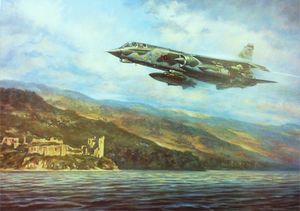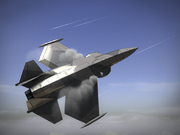S-1 Broadweaver
| S-1 "Broadweaver" Bomber | |
|---|---|
 An S-1A Broadweaver cruising along the Staynish coastline during the 1972 Fort Staynes Campaign | |
| Type | Strategic bomber |
| Place of origin | Norograd |
| Service history | |
| In service | 1970- |
| Used by |
Norogradian Air Force(historic) Ethalrian Air Force(historic) Nilovian Air Force Axdel Air Force(historic) |
| Wars | Auroran Imperial War |
| Production history | |
| Designer | Hartley Aerospace |
| Designed | 1964 |
| Manufacturer | Aerial Warfare Division of Norograd |
| Unit cost | 10.5 million Kiribs (1975) |
| Produced | 1970-1984 |
| Number built | ~1000+ |
| Variants | 8 |
| Specifications | |
| Weight | 24.8 tonnes |
| Length | 27.13 m |
| Width | 11.32 m |
| Height | 7.25 m |
| Crew | 2 |
|
| |
Main armament |
6x 1000lb Bombs in internal bay |
Secondary armament |
4x Underwing pylons armed with ASM's or ARM's (S-1A) |
| Engine |
2x Kersivius Turbojets 100KN each (dry thrust) 140KN each (full afterburner) |
Operational range |
4,750 km (S-1A) |
| Speed |
mach 2.75 at 40000ft/12000m mach 1.5+ at sea level (S-1A) |
The S-1 Broadweaver is a supersonic strategic bomber designed in 1965 by Hartley Aerospace for use by the Morstaybishlian Royal Air Force, but was rejected during development. It instead saw heavy use primarily by the Norogradian Air force during the Auroran Imperial War and up until the turn of the millennium. It was one of the fastest bombers ever put into production, its incredible speed at all altitudes allowing it to outrun fighters and penetrate deep into enemy territory, flying at low altitudes to avoid being detected by radar. During the war, Broadweavers were clocked exceeding Mach 3 in level flight on multiple occasions, and proved instrumental in the success of allied military operations. The primary drawback of the design was its relatively low payload size, which was a remnant of the original intention of the bomber as a tactical nuclear delivery system, though the S-1B version rectified this issue effectively and became the most widely produced of all the Broadweaver variants.
S-1B and S-1C Broadweavers were exported to Ethalria, Nilovia as well as several other nations with close relations to Norograd, and one is believed to have been captured by the Morstaybishlian Empire at some point during the early 1970's. Nilovian use of the Broadweaver is considered by some to have been a major contributing factor in its ability to secure independence in the years following the AIW.
Contents
Variants
S-1A
Standard version, which had a total payload capacity of 4500kg with its four underwing hardpoints and internal bay. Saw production during the early AIW, though went out of production afterwards in favour of more specialised variants. Operational range could be extended with the use of drop tanks on the underwing hardpoints.
S-1AR
Aerial reconnaissance version of the S-1A.
S-1B
Heavy attack version and the most widely produced, with a greater wingspan boasting an extra two underwing hardpoints and muliple mounting points on the main fuselage for additional munitions. It had a larger operational range and far greater payload capacity than the S-1A at the cost of a lower maximum speed, optimised for operations where the threat of enemy high-speed interceptors was low.
S-1C
High performance version. Featured modified high-flow intakes and aerodynamic features, giving it greater fuel efficiency, exceptional operational range and allowing for a Mach 2.9+ maximum speed in level flight. A more powerful radar system gave it additional ability in using air-to-surface missiles and even some limited air-to-air capability.
S-1CR
Aerial reconnaissance version of the S-1C.
S-1CX
Highly modified ultrafast experimental prototype developed in the 1980's using rocket motors instead of turbojets and composite heat shielding as part of a Norogradian shuttle project. Three airframes produced, however one disintegrated mid-air at the undisclosed maximum speed in 1984, killing the pilot leading to the suspension of the project.
S-1D
A version optimised for use as a cruise missile launch platform, featuring strengthened underwing pylons and larger internal fuel tanks.
S-1E
Long-range version with a much larger fuel tank slung below the fuselage and large wings similar to the S-1B though considerably more aerodynamic.
S-1X
Experimental test platform for low-observability stealth features. Only airframe built used as target practice after testing and destroyed. Recovered blueprints suggest features similar to the conceptual S-2 Stormweaver and afterburning turbofan engines instead of turbojets.

